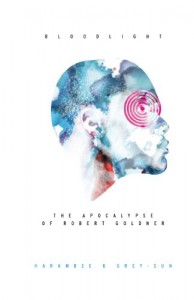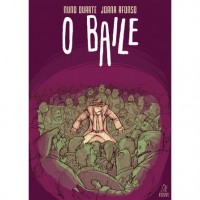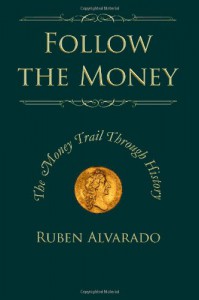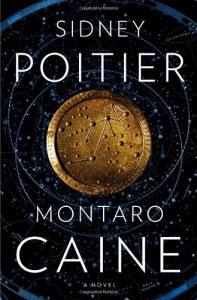Omnilogikos: literati
I'll post here all the book related content that I usually share on my blog, be it comments, reviews, quotes or whatever else.
Currently reading
Hän Solo de Rui Lacas
Ora aqui está uma BD que li apesar de ter sido desaconselhada. A verdade é que gosto de ir dando uma vista de olhos ao que é publicado a nível de banda desenhada em Portugal e ainda que os primeiros leitores de Hän Solo me tenham dito que não valia a pena o esforço, a minha teimosia venceu, agora que a minha memória foi reavivada pelo facto deste livro ter sido premiado numa convenção de BD recente.
Hän Solo é um trabalho que versa um momento da vida de Hän, um holandês bipolar que depois de fazer Erasmus em Portugal acaba por decidir cá ficar a tentar a sua sorte. Rui Lacas tem aqui uma base que lhe permitiria imensas possibilidades de exploração, desde a situação de um estrangeiro em Portugal, o preconceito, a xenofobia ou a aculturação; a relação amorosa estranha com uma portuguesa; o facto de querer trabalhar como fotógrafo, a desvalorização da profissão, os problemas de desemprego jovem; a doença bipolar em si ou a sua relação com todos os restantes problemas de Hän. A verdade é que o autor falhou em toda a linha. Depois de criar esta personagem, todas estas coisas foram simplesmente atiradas para o enredo - ou falta dele - até se alcançar um final que resolve uma parte dos problemas quase por magia ou acaso e ignora os restantes.
A ilustração é mediana, sem ser original nem interessante nem especialmente mal conseguida.
Assim sendo, só me falta perceber como é que esta obra foi sequer nomeada para prémios como melhor arte, melhor publicação nacional ou, pior ainda, melhor argumento. Menos ainda percebo como é que o público votou de forma a esta obra ser a vencedora destes três Troféus Central Comics, especialmente considerando que conheço muitos dos outros nomeados e que são trabalhos bastante superiores.
Não recomendo perder tempo com esta obra, a não ser que tenham uma obsessão por conhecer tudo o que é publicado em Portugal.
Esta opinião foi originalmente publicada no meu blog.
"Suppose it were to happen to us, in the civilized world. If 'another form of life' decided to use humans for similar purposes, and being out on a mission of comparable desperation, as its own resources dwindled, we human beasts would likewise be slaughtered one by one, and those still alive obliged to, in some sense, eat their flesh."
"Oh dear." The General's wife put down her utensils and gazed at her plate.
"Sir, that is disgusting."
"Not literally, then... but we do use one another, often mortally, with the same disablement of feeling, of conscience... each of us knowing that at some point it will be our own turn. Nowhere to run but into a hostile and lifeless waste."
"You refer to present world conditions under capitalism and the Trusts."
"There appears to be little difference. How else could we have come to it?"
"Evolution. Ape evolves to man, well, what's the next step - human to what? Some compound organism, the American Corporation, for instance, in which even the Supreme Court has recognized legal personhood - a new living species, one that can out-perform most anything an individual can do by himself, no matter how smart or powerful he is.""
Skim by Jillian and Mariko Tamaki

I borrowed Skim after reading a friend's review. This graphic novel uses the life of a 16 year old overweight Wiccan-in-training girl to explore various aspects of being a teenager.
The story of Skim - also the girls nickname - is at a turning point. Throughout the book she experiences some situations that question the typical dramas of adolescence. Themes such as peer acceptance, normality and prejudice, passion, self-discovery, true or circumstantial friendships or the will to disappear or suicide are tackled more or less superficial as the story progresses. The three main issues that support this exploration are a friend's suicide, falling in love with a teacher and a strange asymmetric friendship with Lisa. The pace is set and kept by moments when Kim writes on her diary, in pages with a different organization and illustration, which include comments that show what she is learning or discovering and, with no lack of irony, help to transmit the message to the reader.
The illustration is effective though not specially beautiful or original.
Skim is a graphic novel about teenage that goes through multiple of its characteristic problems and points to some lessons though never feeling patronizing or overly dramatic, doubtlessly of interest to fans of comics or of this theme, despite not being as deep in its analysis as it could have been.
This review was originally published in Portuguese and English on my blog.
Bloodlight - The Apocalypse of Robert Goldner by Harambee K. Grey-Sun

Grey-Sun's prose isn't specially well achieved neither in event narration nor in the wording of the main character's thoughts. The dialogues were in general simple and straightforward, adding little or nothing to the story apart from a needed interruption to the otherwise never-ending narration.
Although not terrible, Bloodlight was a disappointing read that failed to achieve the author's purposes and ended up making me give up on reading the trilogy that follows this prequel.
O Baile de Nuno Duarte e Joana Afonso

Fiquei interessado nesta BD pela sua ilustração e a leitura mostrou-me que a minha primeira impressão foi certeira.
O Baile é uma história de horror em que um inspector da PIDE se vê a braços com zombies, como a capa já dá a entender. O argumento de Nuno Duarte é simples, sem especiais erros a apontar mas igualmente sem nada a destacar. As personagens não têm tempo de ser exploradas mais do que superficialmente e até a personagem principal passa a história a ser empurrado pelo enredo até ao final. O próprio não é especialmente original, sendo no fundo mais uma versão das histórias de bruxaria em que o culpado, lembrando os policiais, é revelado num clímax final.
Por outro lado, o desenho de Joana Afonso é a jóia deste livro. Com um traço diferente do habitual, a autora tem uma excelente capacidade de contar a história por imagens, como compete a um ilustrador em banda-desenhada. As cores que complementam o desenho estão adequadas à historia e ao contexto proposto.
Sendo assim, um livro a que vale a pena dar uma oportunidade essencialmente pela arte gráfica, com uma história que entretém sem surpreender. Estarei atento a novos trabalhos de Joana Afonso.
14 by Peter Clines

"
George Orwell, A Clergyman's Daughter (1935)
The Classic Horror Stories by H.P. Lovecraft

Follow the Money: The Money Trail Through History by Ruben Alvarado

The Inner City by Karen Heuler

Another book I had the opportunity to read through NetGalley, and this time a blind bet, considering I didn't even know the author and the description wasn't really specific. No regrets. Though, as is unavoidable in anthologies, there were some stories I liked much more than others, in general the book was very interesting, with some original ideas and approaches different from what I'm used to.
On her website, Karen Heuler says she writes magic realism, lead there by reading Gabriel García Márquez, and I do see some similarity between some of her stories and the little I've read of Haruki Murakami, other author associated with this genre. I still can't move past my feeling that this is but another part of speculative fiction isolated from science fiction and fantasy and associated with literary fiction for commercial reasons.
Side note apart, as an anthology of short tales - be them whatever genre one says - The Inner City is an interesting work that allows for an exploration of the individual's reaction to some odd situations - often quite surreal - which end in a self-analytical tone. The plots are of such an heterogeneity that one can only understand it knowing that they were published separately between 1997 and 2011. From kids that turn into animals, human-dog hybrids to people born from the ground like plants (though adult, dressed and decided) and others that become part of an alien ocean that reminded me of a syncytium, anything can happen in the works of Karen Heuler. Addressing themes such as bio-genetic experimentation, ecology, religion and social engineering, what's new here is the simple and natural way in which characters deal with the awkward situations, allowing the author to lead the reader through unexpected paths. The focus is always on the person, her vision of the phenomena, her participation in or behaviour facing them and what she turns into or finds out about herself, creating a narrative that reminds me of Kafka or even Camus. The reader is shown realities that constantly question his concept of person, of society, of humanity or morality.
A recommended work to all those who enjoy speculative short fiction. I now want to read more of this author, any suggestions?
This review was originally published on my blog in portuguese and english.
Montaro Caine by Sidney Poitier

I found Montaro Caine at NetGalley and decided to request it not only because of the author but because the description enticed me. The book is, bottom-line, the story of Montaro Caine's life, the CEO of a mining-chemistry corporation apparently on the verge of loosing its control. As the tale is told, we start to understand Montaro as an atypical individual, with a complicated youth and a grandfather who he sees not only as a father-figure but as a true guide. Simultaneously, the apparently parallel plot starts to be developed, as we read about a child who is born with a coin in her hand. This is what shows we are about to read some sort of speculative fiction and also what made me curious enough to keep reading. Eventually, as Montaro and this coin with impossible materials become more connected, he is lead into some complicated situations all at once, be it negotiations with millionaire collectors, scams and troubles with his family and even the return of people and stories from his own past. Of course all these loose ends come together at an ending that is centred around Montaro, but not at all solely focused on him.
Montaro is a well developed character, with fleshed out motives and decisions, character and imperfections, and interesting interactions with the company, his employees, his family, where he makes sense without seeming too pushed into stuff just for the sake of the plot.
Unfortunately this is all that's good with this book. The issue with the mysterious coin ends up being quite predictable in a very superficial and far from original approach to science fiction. The ending was ruined because it gave centre stage to the worst of this novel, the preaching. The author is quite paternalistic in the way he conveys his message of self-confidence, hope, union and effort, and at times gets close to what Paulo Coelho does on his books (and also, I imagine, to what the Secret has to say). The book is at its best when the author escapes from those moments. One example of what annoyed me is his interaction with his grandfather. Montaro comes with a very objective doubt, a practical issue that he can't find the solution to, speaks with his grandfather who, in a lot of different ways, usually tells him to trust himself and eventually he comes up with a solution. Once this would be fine, everyone needs a confidence boost once in a while, but for this to be the means to solve problems seems to me quite stupid.
There is a very positive message in this novel, one that tells us that we should unite and work together towards our common progress, here conveyed by the coin and science as a means to the betterment of humanity. However, the fact that the author preaches this instead of showing and associates the message with the magical effect of hope and motivation spoils what could have been, at least conceptually, an interesting story. As it is, this is a passable read with a good protagonist which will please those who enjoy the negotiation, bluff and overall playing and taking advantage of each characters' interests but will be below the expectations of more experienced readers - specially in science fiction - and one that I thoroughly do not recommend for people who can't stand preaching narrators.
This review was originally published on my blog in Portuguese and English.
The Beautiful Thing That Awaits Us All by Laird Barron

I asked for an advanced e-version of this book from Netgalley because I really liked the name and cover and also because it's about time I read some good horror stories. The Beautiful Thing That Awaits Us All is not only the first of Laird Barron's works I've read but also the first time I read a horror anthology. I haven't even read H.P. Lovecraft, I'm afraid. So take this as a beginner's review, someone who didn't really have specific expectations or previous works in the genre to compare to. The book will be made available on April the 2nd.
This book collects nine stories and I'll start by talking a bit about each of them.
The first tale is Blackwood's Baby, a nice introduction into the theme and the author's apparent intent. We follow a hunter who gets invited to a special hunt, in a forest known to be haunted or else associated to some supernatural infernal being and those who cut deals with him. We are given all the campfire chills we would expect from such a typical setting, but at a pace and with such a surprising build up and development that puts it miles away from most of the plots we see in horror films. Barron even has space to explore some issues of social hierarchy but the two things that stand out in Blackwood's Baby are the main character, a complex and mysterious Luke Honey who really drives the story, and the ending which keeps nagging you at the back of your mind long after you've read it. I noticed that while at first, just after finishing the story, I was rather confused, probably because I am not used to this kind of theme and storytelling, after delving more into the book I came to like it much more. The fact that the author doesn't put all the evil in the supernatural beings and allows the humans to have the worst intentions and actions gave me hope that this would be something more than a bunch of scary stories.
After all the weirdness of the first one, The Redfield Girls starts off as a very simple story. Some women who travel on vacations together, this time forced to take a new element, Bernice's niece who appeared without warning at her door the day before the trip. Of course they had to go to a a place with a lake which here represents the unknown and scary and also the place where Bernice's aunt died years ago. The characters are very believable and their actions seem genuine but the plot, apart from one or two good moments, is somewhat predictable and the spookiness didn't work as well as in other cases. I liked The Redfield Girls, mostly for the "girls" themselves and for the play the facts versus its interpretation and people's imagination of lack thereof, but it's far from the best story here.
Hand of Glory on the other hand is my favourite story of the collection and the only one I felt I'd keep on reading if there was more written on those characters and setting. Johnny Cope - the main character - is a hit-man who was attacked and sets out to investigate and get some good old revenge, something that turns out to be much more complicated that he thought. The whole investigation, the weird people he meets, the dark magic abounding and the overall uncertainty are really well played but the strong point is the development of the character and the insight into who he is, who he thinks he is or even who he wishes he could be. This becomes even better because at the same time he questions himself, his motives or purpose, he also feels he is surrounded by people of unknown or ever shifting allegiances and unreliable information. Laird Barron brings us a truly character driven story with a horror and suspense setting which works just right. Add up references to real people and history with a twist and some unique villains about whom we are never sure of anything and you know why Hand of Glory became one of best short stories I've read.
The next in line is The Carrion Gods in Their Heaven, where we follow an abused wife hiding from her former husband with her girlfriend in an old cabin in the woods. Everybody knows one shouldn't go to such a place if one is a character in a horror story, but if you think it's a bunch of film clichés, think again, the danger might not come from the forest or a haunted shack or whatever. Sometimes it's our own curiosity that dooms us as much as it saves us. This is an original tale based on a known myth of transformation into an animal. I wasn't really hooked by the plot or the characters but I liked the uncertain ending.
In The Siphon we return to what Laird Barron does best, a plot that gives the story a structure while allowing the reader to have some insights into the mind of the weird characters he creates. The main character is a psychopath but so are some others he meets in a tale where the greed of humans is paralleled with the hunger of some supernatural beings whose revelation, description and actions will make you squirm until the very end.
The Jaws of Saturn take us back to the setting of Hand of Glory, though even the very same Phil Wary manipulating and using people to his dark intent isn't enough to make it as interesting a story as the previous one. There is something more predictable and less scary about this plot and its main character. In spite of that, I liked the reference and the feeling I was slowly getting to know Phil, here portrayed as a dark magician in the open, all resistant to bullets, super strength and mind-control.
What to say about Vastation? I think the author had to try an array of psychoactive drugs in order to come up with this kind of storytelling. It's a surreal look into the mind and "life" of a godlike being, someone who is immortal, capable of time-travel and of all sorts of other superhuman things. In spite of all this lack of clarity, Vastation ends up being the best story at evoking a feeling of life (and death) as a circle and of how boring it all would become if one had to exist outside of it. Though it is true for all other, this was the story that most suffered from interrupted reading. If you can, read it all at once or at least during the same day. I believe the experience will end up much better than if you do otherwise.
The Men from Porlock is another very good horror tale that uses a forest to place the characters in a context where everything can happen, where the unknown is full of possibilities, where finding an isolated community who sacrifice people is both believable and terrifying. The name should tell most of the veteran readers that these men are as unwelcome interruption and by now one already knows what Laird allows his characters to do or suffer but it's the way things are revealed that makes this one of the best stories in the collection. And to think they only wanted to hunt for some food.
The last tale, More Dark, gives a weird ending to the book and was, unfortunately, the only one I didn't enjoy reading. This is due not only to the rather confusing text but also and mostly because it is a reference to real people, mostly horror authors I suppose, of whom I know nothing. This, added to the lack of explanation or insight into who the people in More Dark are made me feel uninterested and even bored at times, in spite of the looming darkness the author was still able to transmit. Some kind of metafiction in a genre I know little about couldn't work for me.
As a whole, this was a good collection, with a very good but versatile prose and a pervasive unsettling feeling - which probably comes from the fact that Laird Barron tends to describe the scariest moments and revelations as if the characters were in fact hallucinating. Connecting the stories is not only this hallucination but also that sensation that there is always something lurking in the shadows, on the corner of the character's eye (or is it on the corner of my eye?) that we never really grasp. The references to myth and culture and the characters or ideas that appear in more than one story add to the excitement and make the anthology work as a whole. The different ways the author explored death are still with me, making me think about ends, beginnings, transitions and even considering the possibility that most of the moments we see as endings, destructions or disappearances, are thought of as such because of our own lack of knowledge and self-confidence. Most of those moments end up as being little transitions into "more of the same". Might death be, in spite of all the awe and terror most cultures and religions associate with it, just another one of those, a way into something quite like the life we had until then?
As a final note, I must say that even though I'm not really into reading horror - by itself, as entertainment, I prefer epic fantasy or science fiction - Laird Barron convinced me with the main characters he creates, some of the best, most complex and fleshed out I've seen in short fiction. My favourite stories were Hand of Glory, The Siphon and The Men from Porlock, previously published in The Book of Cthulhu II, Blood and Other Cravings and The Book of Cthulhu, respectively.
If you like horror, read The Beautiful Thing That Awaits Us All. If you want to try it out and feel like you need some strong characters and thought-provoking stories to enjoy it, then Hand of Glory is definitely for you. If you don't like horror stories, undefined mythologies and unexplained mysteries, stay away from this. In my case, if I ever return to horror anthologies, I'll be sure to look for Laird Barron in the participant authors list.
The thing that awaits us all, according to Laird Barron, beautiful is not.
This review was originally published on my blog.
Notas Soltas Da Corda E Do Carrasco de Sérgio Godinho (DN Contos Digitais #31)

Este conto é uma leitura interessante em que se explora a mente de um carrasco que revê a sua vida no momento em que está prestes a ser submetido à pena de morte. A ironia da vida parece fazer algum sentido na cabeça do homem que vai ligando os pontos e explicando a si mesmo - e ao leitor - como é que tudo levou a esta situação. Não é um conto que me traga especial novidade, mas é sem dúvida uma leitura agradável na qual alguns pensamentos se destacam da narrativa e suscitam uma reflexão sobre o matar e o morrer.
Os meus comentários a todos os contos da colecção estão publicados no meu blog.
Dama Polaca Voando Em Limusine Preta de Lídia Jorge (DN Contos Digitais #30)

Embora haja um aparente interesse em explorar as ideias de preconceito e de reacção ao desconhecido, na prática o conto de Lídia Jorge acaba por ser um aborrecimento. A escrita não é má, em especial comparando com outros contos nesta colecção, mas o esboço de enredo não segura o interesse nem me deixa a pensar em nada e as personagens são irrelevantes.
Os meus comentários a todos os contos da colecção estão publicados no meu blog.
Férias Com Um Casal Amigo de Ricardo Adolfo (DN Contos Digitais #29)

Numa óbvia crítica à sociedade actual, em que se vive de aparências mesmo com a crise a obrigar grande parte das pessoas a mudar completamente as suas vidas, o conto de Ricardo Adolfo conta-nos a história de dois casais que se escondem em casa enquanto fingem, para si e para os outros, que viajaram para o Brasil de férias. Os miúdos, sempre honestos quando os pais precisam que eles mintam, não colaboram tanto assim e servem de comparação com os adultos que tanto se dobram a este tipo de supostas exigências sociais. Há ainda uma referência ao Fifty Shades of Grey, provavelmente para adicionar à crítica que se faz a este tipo de pessoas, fúteis e idiotas. Se isto parece ter potencial, e se calhar tem, o facto é que o conto em si é absolutamente desinteressante. Segue-se esta gente, os seus diálogos inconsequentes - sabe-se lá porquê sem letras maiúsculas ou pontos finais - até ao clímax da idiotice, que dá em loucura e que evita uma confrontação que talvez explorasse melhor o tema. Assim, limita-se a ser uma descrição superficial de um par de dias patetas.
Os meus comentários a todos os contos da colecção estão publicados no meu blog.
O Fim Da Dívida de Nuno Costa Santos (DN Contos Digitais #28)

Tal como o título indica, este conto fala de dívida e tudo nele parece ser intencionalmente construído para ser uma brincadeira séria com a dita dívida e decorrente situação portuguesa nos últimos anos. Infelizmente a passagem da ideia à prática não correu bem e o texto acaba por ser pouco estimulante e completamente desinteressante.
Os meus comentários a todos os contos da colecção estão publicados no meu blog.










 1
1

